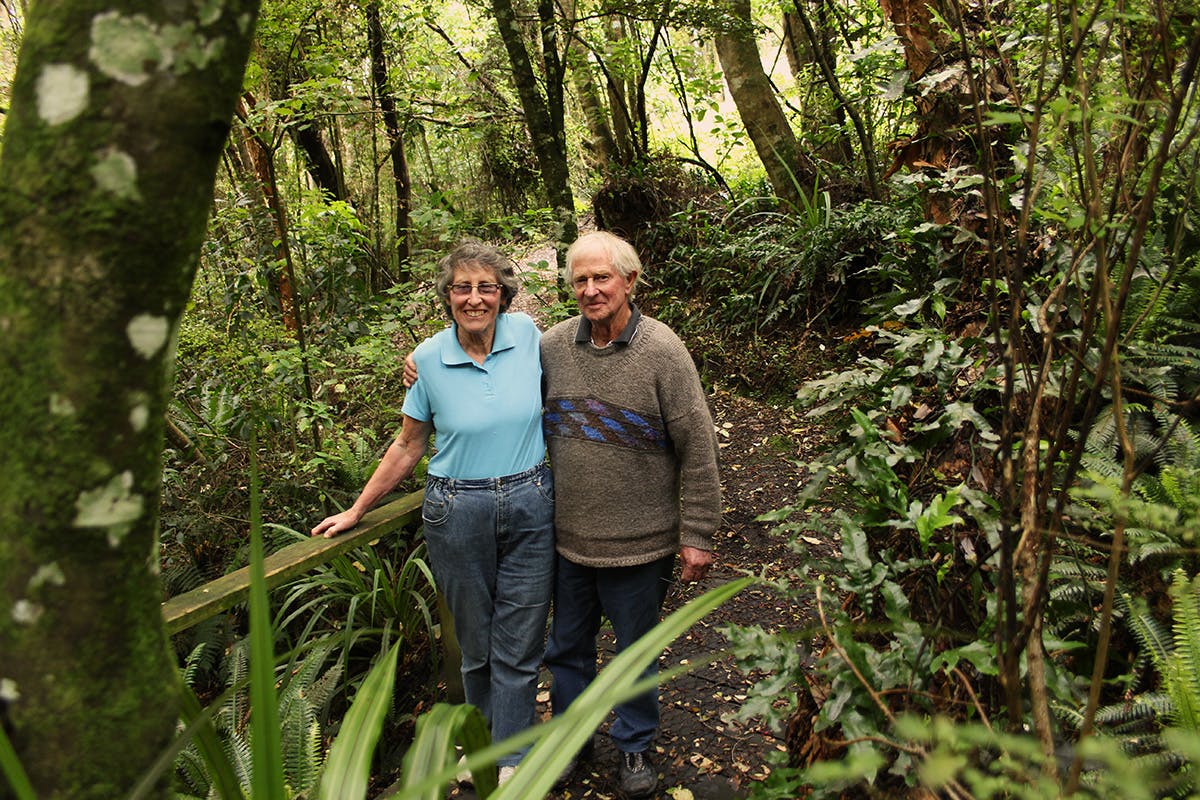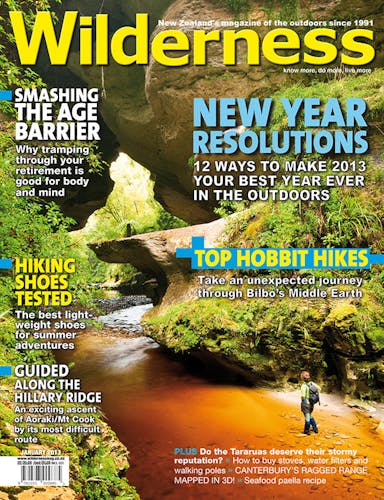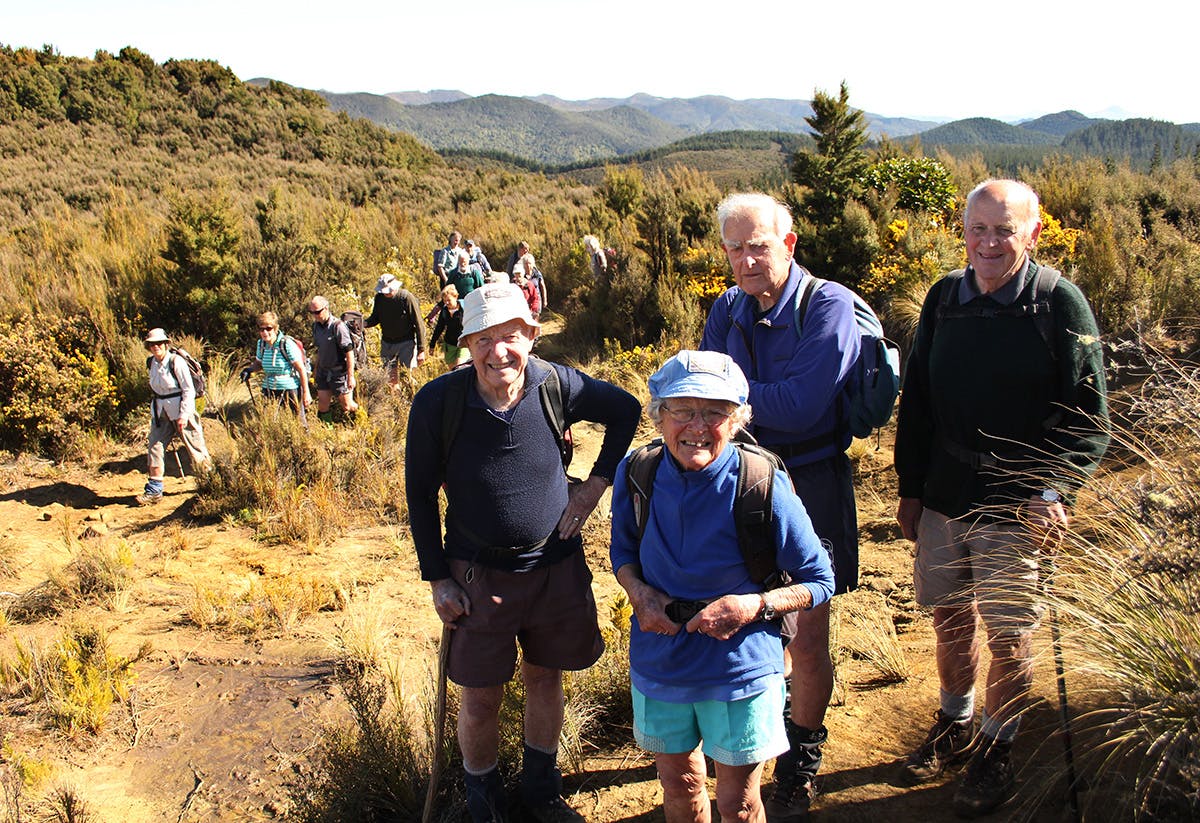When it comes to tramping, age is no barrier and over-65’s who take to the hills can even expect to be sharper mentally and live longer
The legs striding up the track in front of me are slim, tanned and muscled.
Their owner chats easily to the tramper in front and throws back the odd question.
As the track steepens, I’m starting to puff a little, my answers interjected with gasps for air.
Fair enough, I am carrying a 13kg toddler on my back after all, but I thought the extra weight would have evened us out a little, given most of the 20 or so trampers around me are at least twice my age.
In fact, the owner of the slim, tanned and muscled legs, Isobel Hatherly, has 44 years on me, and I have the nasty feeling that if I joined this group for a day in the hills, I might struggle to keep up with the 83-year-old, even without a toddler on my back.
Today, however, I am just along with this over-60s tramping group until we find a nice vantage point on the track to take a photograph.
As we walk I am surprised to learn that many in the group are actually over 70, and four of them are into their 80s.
I am also surprised to learn this is not the only group of older trampers in Dunedin. The Dunedin Over-60s Club has four different walking groups, ranging from ramblers and hikers to trampers, to meet demand, and there are numerous other clubs and organisations in the city catering for trampers in their retirement years.
A few days after waving goodbye to Hatherly and her group, and wishing them an enjoyable day up the 639m Green Hill, I visit the diminutive, five foot-nothing grandmother in her home.
“I really don’t think I could possibly have anything interesting to tell you,” she says, waving me towards a comfortable, sheepskin-lined rocking chair. As I take a seat she flops into a bean bag on the floor in front of me, and I refrain from replying I don’t know of any 83-year-olds who could get in and out of a bean bag with such ease, never mind tramping twice a week.
If ever there was a living example of the old adage, ‘it’s never too late try something new’, this inspiring lady is it.
Hatherly grew up in the outdoors, riding ponies with her sister around a farm in the Waikato. But it wasn’t until well after she retired from a career as a primary school teacher that she discovered tramping.
Formerly a widower, she was looking for company and a way to keep fit when she read about the over-60s tramping club in the newspaper. She recalls she was about 64-years-old when she turned up for her first tramp with the group, wearing “some sort of brogues”. The leader of the group looked at her feet and asked if she was sure her footwear was adequate?
“I’ve been through a lot of tramping boots since then,” she says.
The challenges and the friendships are what Hatherly enjoys about tramping.
She was in her mid-70s when she tackled Fiordland’s remote eight to 10-day Dusky Track with a group of friends.
“When we went in to get our hut tickets they sort of looked at these old people and said ‘you are taking a radio with you?’.”
This demanding tramp crosses three major valley systems and two mountain ranges, and is renowned for its knee deep mud, heavy rain and floods, more than 20 three-wire bridges and having to haul yourself up steep mountain sides on tree roots.
It was a tough tramp, but the sense of achievement at the finish was amazing, Hatherly says. “I just sort of glowed with it.”
Tramping also brought another unexpected glow to Hatherly’s life – love. She met her second husband, Keith Paullin, through tramping.
Paullin, 83, also came to tramping late in life. He developed asthma and was about 64 when his doctor told him he needed to “get out and increase his anaerobic capacity”.
The fitness gained through tramping made a huge difference and now it would be strange to not be out tramping every week, he says. “Once you stop you would get fat and lazy, and your health would go downhill.”
The hills it would seem foster strong passions.
Eighty-two-year-old Murray Bolt has always loved the outdoors, spending a lifetime tramping and climbing in the mountains. Still a member of the New Zealand Alpine Club, he was very active with the club in his younger days, even travelling to Antarctica as a club member to explore an untouched valley where they discovered new life.

Brian and Jan O’Callaghan still enjoy multi-day tramps, but their favourite patch of bush is just up the road from their Kaka Point home. Photo: Edith Leigh
He too, a former widower, met his second wife, Shirley, while out tramping, and while he recently stepped down from a leadership role with the over-60s tramping club, the pair still join them every week and often go for long walks together as well.
Bolt hails from the days of nailed boots and chopping steps up snow slopes with a massive ice axe that “would be laughed at these days”.
There was no Gore-Tex, luxuriously soft second-skin merino knits, or even the bonus of your own bunk in a hut. “We used to have the old bush-shirt and a pair of shorts, and that was it.”
Oilskins were used for raincoats and boots were made tough. “Before you actually wore them into the hills you left them soaking in a bucket of water for a few days, because you wanted them wet and pliable. Otherwise you would get very sore feet – they were a bit rugged.”
Huts had a straight bunk all in a row, with a mattress if you were lucky, or a bed of snowgrass if you weren’t.
When I ask Bolt if we’re maybe “a bit soft these days”, he doesn’t hesitate with his answer. “Yes,” he replies, his piercing blue eyes suddenly bright and clear, after clouding over with memories of a bygone era.
Of course there is lots of top quality, albeit “very expensive”, outdoors gear available these days, but one of the biggest changes in the outdoors during his lifetime is the sheer numbers of people taking to the hills, Bolt says.
“It’s hammered so much now. The huts are huge and they take lots of people.”
He shakes his head at the idea of having to book to walk a track, or not being able to pitch a tent where you want.
“Many of the areas, I think they tend to get a bit overcrowded.”
It was a change that, until recently, he and a few old ‘cobbers’ used to get around by heading off on mid-winter missions.
In the past they have headed up the Hopkins, into the Hollyford or the Takatimus.
“You get huts to yourself, at a cheap rate, with plenty of firewood and long hours in the sack. You just make your own pace.”
Climbing mountains might be “a young man’s game,” but he still loves to be in that environment.
At 71 and 72 years of age respectively, Brian and Jan O’Callaghan would be considered mere spring chickens by Bolt, but the keen trampers and conservation volunteers share his sentiments about overcrowded tracks and hills.
The Kaka Point couple, who also met through tramping, love nothing more than heading off on a multi-day track, but do all their tramping out of season to avoid the crowds.
They don’t do the Great Walks because they object to the cost – up to $55 a night each – but they enjoy tracks such as Fiordland’s Hollyford Track, Canterbury’s St James Walkway and they recently returned from a week on the Greenstone and Caples tracks.
One of the biggest changes they have noticed is that the huts are filled with overseas tourists, and they come across few other Kiwis, they say.
When she first started tramping in her youth, “you never, ever saw a tourist” in the huts, Mrs O’Callaghan says.
Mr O’Callaghan comments that perhaps huts should be free for over-65s. After all, the Great Walk huts are free for under-18s, but what about people at the other end of the spectrum?
One of the biggest advantages to being retired is that they can head to the hills whenever they want. Today’s good weather forecasts means they can pick their moment, and they almost always have nice weather while tramping, Mr O’Callaghan says.
“We start about 10 days out. We will be all packed with everything ready to go and then we’ll say ‘right, we’re away’.”
These days they also always carry an emergency locator beacon, something that wasn’t around in their youth.
The most adventurous trip they ever tackled was a three-week epic following the trackless West Coast from Jackson’s Bay to Milford Sound.
During the trip, Mr O’Callaghan cut his leg badly while skinning a rabbit. One of their fellow trampers, a medical trainee had stitched up rats in the laboratory, so he gamely stitched the leg up – without any pain relief – and they then waited out the rain in a hut for a week to give the leg a bit of time to heal before continuing on.
“It’s just so different today; you would whistle up a helicopter,” Mr O’Callaghan says.
Perversely, for 80-year-old George Sutherland, it was a heart attack that led him to rediscover his love for the outdoors 22 years ago.
In the months following his heart attack he could barely walk to the first power pole beyond his garden gate. Then he joined a heart attack survivors club that had a tramping group.
But it wasn’t until he had tramped every track Dunedin’s Silver Peaks had to offer that he found his niche in the hard yards of track maintenance.
Every Wednesday he can be found at the end of a shovel, a grubber, a scrub cutter or a lawn mower, as the group he formed, the Green Hut Track Group, works to maintain 60km of tracks.
The group has expanded beyond heart attack survivors, but most of their workers are in their 60s and 70s, with “a few younger ones”, Sutherland says.
When he first started he couldn’t wait for the next week, so he could get back out, and he would be sorely disappointed if it was raining and they couldn’t go.
“Working in the bush is far better than tramping,” Sutherland says.
There is the tramp to get to where they are working, the excitement of the work as they improve the track and then the satisfaction of a job well done when the track is improved for everybody to use.
Sutherland’s aim is to get more people out enjoying the outdoors and the group makes a huge difference to the tracks, some of which had been “completely overgrown”, or almost impassable due to slips.
“It’s great for the body. The doctor says hard work is what we need. We get really exhausted, but he says that’s good.”
An added bonus for Sutherland, who still skis every winter, is that his skiing improved considerably with the hard work.
University of Otago Professor of geriatric medicine John Campbell says when it comes to ageing it really is a case of use it or lose it.
Where a younger person might use 70 per cent of their muscle strength to jump out of a chair quickly, a person over 80 would need to use 100 per cent muscle strength to get up slowly. Therefore, as an older person loses muscle strength, they lose functionality.
“So it is very important to continue to use it,” Campbell says.
Tramping is great all-round exercise, good not just for muscles, but also for heart and lung capacity, balance, joints, and even the brain.
Studies have shown that an older person’s ability to think actually improves with exercise.
“There is no doubt maintaining physical health maintains mental health,” Campbell says.
Tramping also has the advantage of providing not just physical exercise, but social interaction with a group. Another recent study measured four factors among older people – physical activity, diet, smoking and how connected they were with other people and their community – and found those who scored well in all four lived considerably longer, Campbell says.
So with such a raft of benefits provided by tramping, age is simply no excuse not to be out in the hills.








